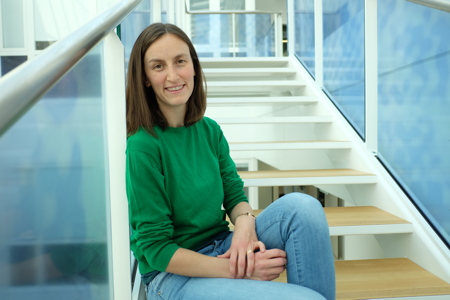Sigrid Milles is a CNRS researcher at the Institut de Biologie Structurale. Her project, named ‘MultiMotif’, has been selected for funding through an ERC Starting Grant over the next five years. Scientific excellence at European level is one of the main criteria for the selection of these awards which recognize innovative projects of promising researchers, who finished their doctorate 2 to 7 years ago and want to create or consolidate a research team.
After a PhD on single molecule fluorescence spectroscopy at the European Molecular Biology Laboratory (EMBL) in Heidelberg, Germany (2013), Sigrid Milles joined Martin Blackledge’s group at the IBS for a postdoc in nuclear magnetic resonance (NMR) spectroscopy. During her thesis and postdoctoral studies, Sigrid studied intrinsically disordered proteins, that means proteins without a stable three-dimensional structure. She was first interested in the proteins of the nuclear pore complex, a transport channel that connects the nucleoplasm and the cytoplasm, and her work has allowed to understand how transport through the pore can at the same time be fast (milliseconds) and specific (published in Cell, 2015). More recently, Sigrid worked on the intrinsically disordered proteins of the measles virus replication machinery and she has just discovered a new interaction site between two viral proteins (published in Science Advances, 2018), which might present a new future target to treat measles infection. She got recruited by the CNRS in 2017 and aims now to combine fluorescence and NMR spectroscopy to study the intrinsically disordered proteins in endocytosis – the major transport pathway into the eukaryotic cell.
What is this project about?
Endocytosis is responsible for the entry of molecules into the eukaryotic cell, as for example nutrients, signaling molecules and their receptors, but also pathogens. This mechanism is thus very important and relies on the small molecule clathrin (clathrin-dependent endocytosis), which forms the structural scaffold shaping the membrane and finally resulting in the uptake of a coated vesicle. However, a lot of other proteins are necessary for this highly regulated uptake process, amongst others proteins that contain long intrinsically disordered regions. These regions are interspersed with small sequence stretches, called linear motifs, which interact with different binding partners from the endocytosis machinery. Although these interactions are crucial for endocytosis, they are not very well understood due to the flexibility and dynamics of the protein sequences they are embedded in.
This ERC project aims at developing an integrated approach using single molecule fluorescence and NMR spectroscopy to study these intrinsically disordered proteins and understand the molecular mechanism by which their linear motifs regulate the process of endocytosis. Understanding the way of function of these motifs is important not only for endocytosis, but also many other biological processes that also rely on using linear motifs.
